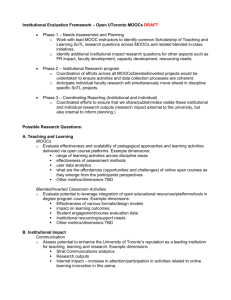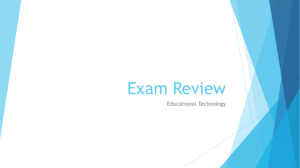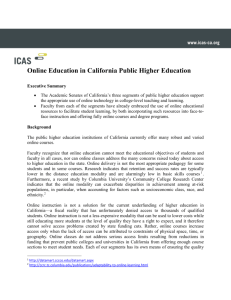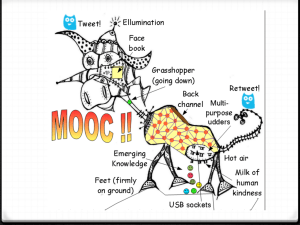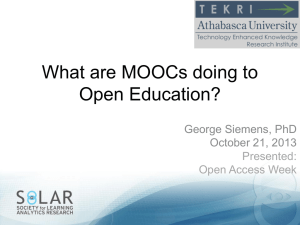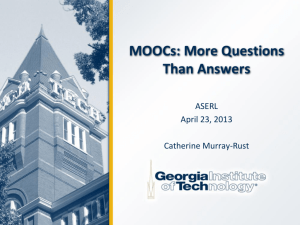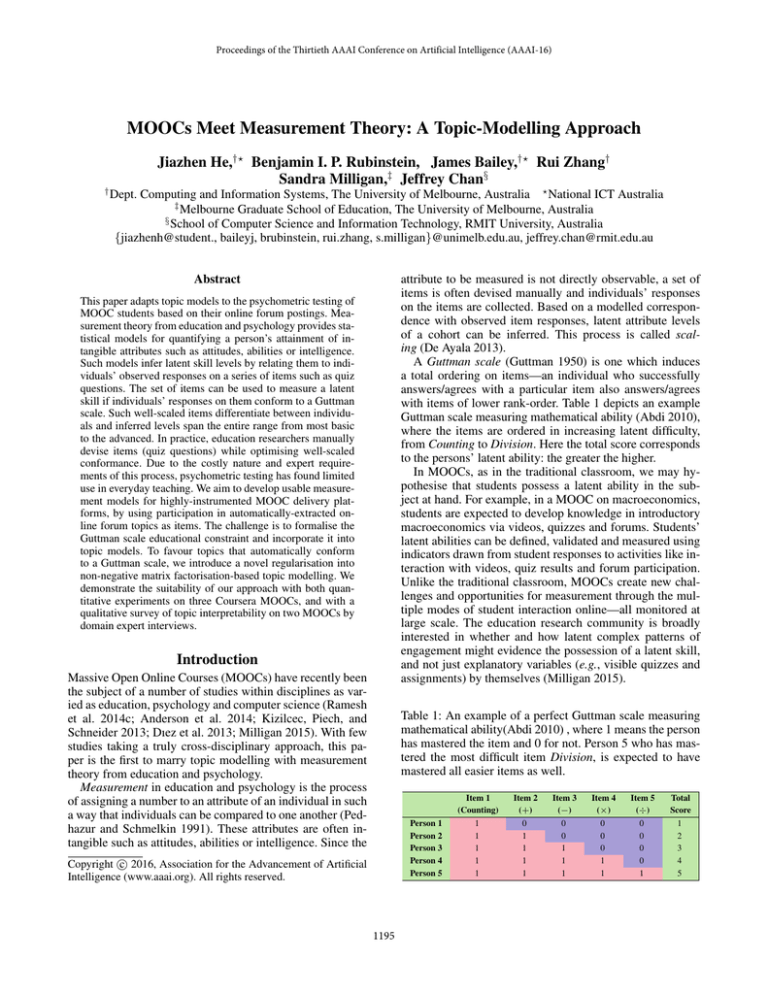
Proceedings of the Thirtieth AAAI Conference on Artificial Intelligence (AAAI-16)
MOOCs Meet Measurement Theory: A Topic-Modelling Approach
†
Jiazhen He,† Benjamin I. P. Rubinstein, James Bailey,† Rui Zhang†
Sandra Milligan,‡ Jeffrey Chan§
Dept. Computing and Information Systems, The University of Melbourne, Australia National ICT Australia
‡
Melbourne Graduate School of Education, The University of Melbourne, Australia
§
School of Computer Science and Information Technology, RMIT University, Australia
{jiazhenh@student., baileyj, brubinstein, rui.zhang, s.milligan}@unimelb.edu.au, jeffrey.chan@rmit.edu.au
attribute to be measured is not directly observable, a set of
items is often devised manually and individuals’ responses
on the items are collected. Based on a modelled correspondence with observed item responses, latent attribute levels
of a cohort can be inferred. This process is called scaling (De Ayala 2013).
A Guttman scale (Guttman 1950) is one which induces
a total ordering on items—an individual who successfully
answers/agrees with a particular item also answers/agrees
with items of lower rank-order. Table 1 depicts an example
Guttman scale measuring mathematical ability (Abdi 2010),
where the items are ordered in increasing latent difficulty,
from Counting to Division. Here the total score corresponds
to the persons’ latent ability: the greater the higher.
In MOOCs, as in the traditional classroom, we may hypothesise that students possess a latent ability in the subject at hand. For example, in a MOOC on macroeconomics,
students are expected to develop knowledge in introductory
macroeconomics via videos, quizzes and forums. Students’
latent abilities can be defined, validated and measured using
indicators drawn from student responses to activities like interaction with videos, quiz results and forum participation.
Unlike the traditional classroom, MOOCs create new challenges and opportunities for measurement through the multiple modes of student interaction online—all monitored at
large scale. The education research community is broadly
interested in whether and how latent complex patterns of
engagement might evidence the possession of a latent skill,
and not just explanatory variables (e.g., visible quizzes and
assignments) by themselves (Milligan 2015).
Abstract
This paper adapts topic models to the psychometric testing of
MOOC students based on their online forum postings. Measurement theory from education and psychology provides statistical models for quantifying a person’s attainment of intangible attributes such as attitudes, abilities or intelligence.
Such models infer latent skill levels by relating them to individuals’ observed responses on a series of items such as quiz
questions. The set of items can be used to measure a latent
skill if individuals’ responses on them conform to a Guttman
scale. Such well-scaled items differentiate between individuals and inferred levels span the entire range from most basic
to the advanced. In practice, education researchers manually
devise items (quiz questions) while optimising well-scaled
conformance. Due to the costly nature and expert requirements of this process, psychometric testing has found limited
use in everyday teaching. We aim to develop usable measurement models for highly-instrumented MOOC delivery platforms, by using participation in automatically-extracted online forum topics as items. The challenge is to formalise the
Guttman scale educational constraint and incorporate it into
topic models. To favour topics that automatically conform
to a Guttman scale, we introduce a novel regularisation into
non-negative matrix factorisation-based topic modelling. We
demonstrate the suitability of our approach with both quantitative experiments on three Coursera MOOCs, and with a
qualitative survey of topic interpretability on two MOOCs by
domain expert interviews.
Introduction
Massive Open Online Courses (MOOCs) have recently been
the subject of a number of studies within disciplines as varied as education, psychology and computer science (Ramesh
et al. 2014c; Anderson et al. 2014; Kizilcec, Piech, and
Schneider 2013; Dıez et al. 2013; Milligan 2015). With few
studies taking a truly cross-disciplinary approach, this paper is the first to marry topic modelling with measurement
theory from education and psychology.
Measurement in education and psychology is the process
of assigning a number to an attribute of an individual in such
a way that individuals can be compared to one another (Pedhazur and Schmelkin 1991). These attributes are often intangible such as attitudes, abilities or intelligence. Since the
Table 1: An example of a perfect Guttman scale measuring
mathematical ability(Abdi 2010) , where 1 means the person
has mastered the item and 0 for not. Person 5 who has mastered the most difficult item Division, is expected to have
mastered all easier items as well.
Person 1
Person 2
Person 3
Person 4
Person 5
c 2016, Association for the Advancement of Artificial
Copyright Intelligence (www.aaai.org). All rights reserved.
1195
Item 1
(Counting)
1
1
1
1
1
Item 2
(+)
0
1
1
1
1
Item 3
(−)
0
0
1
1
1
Item 4
(×)
0
0
0
1
1
Item 5
(÷)
0
0
0
0
1
Total
Score
1
2
3
4
5
This paper focuses on using the content of forum discussion in MOOCs for measurement, which is too timeconsuming to analyse manually but that can provide a predictive indicator of achievement (Beaudoin 2002). We automatically generate items (topics) from unstructured forum
data using topic modelling. Our goal is to discover items
on which dichotomous (posting on a topic or not) student
responses conform to a Guttman scale; where items are interpretable to subject-matter experts who could be teaching
such MOOCs. For example, for a MOOC on discrete optimisation, our goal is to automatically discover topics such
as How to use platform/python—the easiest which most students contribute to—and How to design and tune simulated
annealing and local search—a more difficult topic which
only a few students might post on. Such well-scaled items
can be used for curriculum design and student assessment.
The challenge is to formalise the Guttman scale educational constraint and incorporate it into topic models. We
opt to focus on non-negative matrix factorisation (NMF) approaches to topic modelling, as these admit natural integration of the Guttman scale educational constraint.
Contributions.
tion. Gillani et al. (2014) find communities using Bayesian
Non-Negative Matrix Factorisation. Despite this variety of
works, no machine learning research has explored forum
discussions for the purpose of measurement in MOOCs.
Topic modelling has been applied in MOOCs for
tasks such as understanding key themes in forum discussions (Robinson 2015), predicting student survival (Ramesh
et al. 2014a), study partner recommendation (Xu and Yang
2015) and course recommendation (Apaza et al. 2014).
However, to our knowledge, no studies have leveraged topic
modelling for measurement. More generally, psychometric
models have enjoyed only fleeting attention by the machine
learning community previously.
Preliminaries and Problem Formalisation
We choose NMF as the basic approach to discover forum
topics due to the interpretability of topics produced, and the
extensibility of its optimisation program. We begin with a
brief overview of NMF and then define our problem.
Non-Negative Matrix Factorisation (NMF)
Given a non-negative matrix V ∈ Rm×n and a positive integer k, NMF factorises V into the product of a non-negative
matrix W ∈ Rm×k and a non-negative matrix H ∈ Rk×n
The main contributions of this paper are:
• A first study of how a machine learning technique, NMFbased topic modelling, can be used for the education research topic of psychometric testing;
V ≈ WH
• A novel regularisation of NMF that incorporates the educational constraint that inferred topics form a Guttman
scale; and accompanying training algorithm;
A commonly-used measure for quantifying the quality of
this approximation is the Frobenius norm between V and
WH. Thus, NMF involves solving the following optimisation problem,
• Quantitative experiments on three Coursera MOOCs covering a broad swath of disciplines, establishing statistical
effectiveness of our algorithm; and
min V − WH2F
W,H
• A carefully designed qualitative survey of experts in two
MOOC subjects, which supports the interpretability of
our results and suggests their applicability in education.
s.t.
W ≥ 0, H ≥ 0 .
(1)
The objective function is convex in W and H separately, but
not together. Therefore standard optimisers are not expected
to find a global optimum. The multiplicative update algorithm (Lee and Seung 2001) is commonly used to find a local
optimum, where W and H are updated by a multiplicative
factor that depends on the quality of the approximation.
Related Work
Various studies have been conducted into MOOCs for tasks
such as dropout prediction (Halawa, Greene, and Mitchell
2014; Yang et al. 2013; Ramesh et al. 2014b; Kloft et
al. 2014; He et al. 2015b), characterising student engagement (Anderson et al. 2014; Kizilcec, Piech, and Schneider
2013; Ramesh et al. 2014b) and peer assessment (Dıez et al.
2013; Piech et al. 2013; Mi and Yeung 2015).
Forum discussions in MOOCs have been of interest recently, due to the availability of rich textual data and social
behaviour. For example, Wen, Yang, and Rose (2014) use
sentiment analysis to monitor students’ trending opinions towards the course and to correlate sentiment with dropouts
over time using survival analysis. Yang et al. (2015) predict students’ confusion with learning activities as expressed
in the discussion forums using discussion behaviour and
clickstream data, and explore the impact of confusion on
student dropout. Ramesh et al. (2015) predict sentiment
in MOOC forums using hinge-loss Markov random fields.
Yang, Adamson, and Rosé (2014) study question recommendation in discussion forums based on matrix factorisa-
Problem Statement
We explore the automatic discovery of forum discussion topics for measurement in MOOCs. Our central tenet is that
topics can be regarded as useful items for measuring a latent skill, if student responses to these items conform to a
Guttman scale, and if the topics are semantically-meaningful
to domain experts. As Guttman scale item responses are
typically dichotomous, we consider item responses to be
whether a student posts on the topic or not. Our goal is to
generate a set of meaningful topics that yield a student-topic
matrix conforming to the properties of a Guttman scale, e.g.,
a near-triangular matrix (see Table 1). This process can be
cast as optimisation. We apply such well-scaled topics to
measure skill attainment—as level of forum participation
is known to be predictive of learning outcomes (Beaudoin
2002).
Using NMF, a word-student matrix V can be factorised
into two non-negative matrices: word-topic matrix W and
1196
topic-student matrix H. Our application requires that the
topic-student matrix H be a) Binary ensuring the response
of a student to a topic is dichotomous; and b) Guttmanscaled ensuring the student responses to topics conform to
a Guttman scale. NMF provides an elegant framework for
incorporating these educational constraints via adding novel
regularisation, as detailed in the next section. A glossary of
important symbols used in this paper is given in Table 2.
These rules for the constrained program can be derived
via the Karush-Kuhn-Tucker conditions necessary for local
optimality. First we construct the unconstrained Lagrangian
L(W, H, α, β) = f (W, H) + tr(αW) + tr(βH) ,
where αij , βij ≤ 0 are the Lagrangian dual variables for
inequality constraints wij ≥ 0 and hij ≥ 0 respectively, and
α = [αij ], β = [βij ] denote their corresponding matrices.
The KKT condition of stationarity requires that the
derivative of L with respect to W, H vanishes:
∂L
=2 W H HT − VHT + λ0 W + α = 0 ,
∂W
∂L
=2 WT W H − WT V + (λ1 + λ2 )H
∂H
Table 2: Glossary of symbols
Symbol
Description
m
n
k
V = (vij )m×n
W = (wij )m×k
H = (hij )k×n
Hideal = ((hideal )ij )k×n
the number of words
the number of students
the number of topics
word-student matrix
word-topic matrix
topic-student matrix
exemplar topic-student matrix
with ideal Guttman scale
regularisation coefficients
λ0 , λ 1 , λ 2
− λ1 Hideal + 4λ2 H ◦ H ◦ H
− 6λ2 H ◦ H + β = 0 .
wij = βij
hij = 0, implies:
Complementary slackness αij
wij
,
0= VHT − W H HT − λ0 W
ij
0= WT V + 3λ2 H ◦ H + λ1 Hideal − WT W H
NMF for Guttman scale (NMF-Guttman)
−2λ2 H ◦ H ◦ H − (λ1 + λ2 )H
Primal Program
+4λ2 H ◦ H ◦ H − 4λ2 H ◦ H ◦ H
We introduce the following regularisation terms on W to
prevent overfitting, and on H to encourage a binary solution
and Guttman scaling:
• W2F to prevent overfitting;
• H − Hideal 2F to encourage a Guttman-scaled H, where
Hideal is a constant matrix with ideal Guttman scale;
• H ◦ H − H2F to encourage a binary solution H, where
operator ◦ denotes the Hadamard product.
Binary matrix factorisation (BMF) is a variation of NMF,
where the input matrix and the two factorised matrices are
all binary. Inspired by the approach of Zhang et al. (2007)
and Zhang et al. (2010), we add regularisation term
H ◦ H − H2F . Noting this term equals H ◦ (H − 1)2F ,
it is clearly minimised by binary H.
These terms together yield the objective function
Input:
V, Hideal , λ0 , λ1 , λ2 , k;
Output:
A topic-student matrix, H;
1: Initialise W, H using NMF;
2: Normalise W, H following (Zhang et al. 2007; 2010);
3: repeat
4:
Update W, H iteratively based on Eq. (4) and Eq. (5);
5: until converged
6: return H;
(3)
Selection of Hideal Topic-student matrix Hideal is an
ideal target where students’ topic responses conform to a
perfect Guttman scale. Hideal can be obtained in different
ways depending on the attribute of interest to be measured.
In this paper, we are interested in measuring students’ latent
skill in MOOCs. We envision measurement at the completion of a first offering, with scaled items applied in subsequent offerings for measuring students or curriculum design;
Algorithm
A local optimum of program (3) is achieved via iteration
wij ←wij
hij ←hij
(VHT )ij
(WHHT + λ0 W)ij
(WT V)ij + 4λ2 h3ij + 3λ2 h2ij + λ1 (hideal )ij
(WT WH)ij + 6λ2 h3ij + (λ1 + λ2 )hij
hij .
Algorithm 1 NMF-Guttman
+ λ1 H − Hideal 2F + λ2 H ◦ H − H2F ,
(2)
where λ0 , λ1 , λ2 > 0 are regularisation parameters; with
primal program
min f (W, H) s.t. W ≥ 0, H ≥ 0 .
ij
These two equations lead to the updating rules (4), (5). Our
next result proves that these rules improve the objective
value.
Theorem 1. The objective function f (W, H) of program (3) is non-increasing under update rules (4) and (5).
The proof of Theorem 1 is given in He et al. (2015a). Our
overall approach is described as Algorithm 1. W and H are
initialised using plain NMF (Lee and Seung 1999; 2001),
then normalised (Zhang et al. 2007; 2010).
f (W, H) =V − WH2F + λ0 W2F
W,H
(4)
(5)
1197
Experimental Setup
alternatively within one offering after a mid-term. Thus,
Hideal can be obtained using assessment, which need not be
based on Guttman-scaled items. For each student j, his/her
responses to the topics given by column (hideal )·j are selected based on his/her grade gj ∈ [0, 100], as
where
Evaluation Setting We split data into a training set (70%
students) and a test set (30% students). The topics are generated by optimising the objective function (2) on the training
set, and evaluated using CR and the quality of approximation
V − WH2F . To simulate the inferring responses for new
students, which has not been explored previously, the trained
model is evaluated on the test set using Precision-Recall and
ROC curves. Note that in the psychometric literature, validation typically ends with an accepted (> 0.9) CR on the
training set.
After learning on the training set word-student matrix
V(train) , two matrices are produced: a word-topic matrix
W(train) and topic-student matrix H(train) . To evaluate the
trained model on the test set V(test) , we apply the trained
word-topic matrix W(train) . Together, we have the relations
· · 1 0
· · 0)
(hideal )·j = (1
·
·
b
k−b
gj + width
100
, k , width =
.
b = min
width
k
For example, student j with gj = 35 has response pattern on
k = 10 topics (hideal ).j = (1111000000).
Experiments
We conduct experiments to evaluate the effectiveness of our
algorithms on real MOOCs on Coursera. We also demonstrate the robustness of our approach in terms of parameter sensitivity. In our experiments, we use the first offerings
of three Coursera MOOCs from Education, Economics and
Computer Science offered by The University of Melbourne.
They are Assessment and Teaching of 21st Century Skills,
Principles of Macroeconomics, Discrete Optimisation and
are named EDU, ECON and OPT for short respectively.
V(train)
V(test)
H(test) = H(train) (V(train) )† V(test) .
where (V(train) )† denotes the pseudoinverse of V(train) .
Hyperparameter Settings Table 4 shows the parameter
values used for parameter sensitivity experiments, where the
default values in boldface are used in other experiments.
We focus on the students who contributed posts or comments in forums. For each student, we aggregate all
posts/comments that s/he contributed. After stemming, removing stop words and html tags, a word-student matrix
with normalised tf-idf in [0,1] is produced. The statistics of
words and students for the MOOCs are displayed in Table 3.
Table 4: Hyperparameter Settings
Table 3: Statistics of Datasets
#Words
20,126
22,707
17,059
W∗(train) H(train)
W∗(train) H(test) .
Solving for H(test) yields
Dataset Preparation
MOOC
EDU
ECON
OPT
=
=
#Students
1,749
1,551
1,092
Parameter
Values Explored (Default Value)
λ0
λ1
λ2
k
[10−4 , 10−3 , 10−2 , 10−1 , 100 , 101 , 102 ]
[10−4 , 10−3 , 10−2 , 10−1 , 100 , 101 , 102 ]
[10−4 , 10−3 , 10−2 , 10−1 , 100 , 101 , 102 ]
[5, 10, 15, 20, 25, 30]
Results
In this group of experiments, we examine how well the generated topics conform to a Guttman scale, and the quality
of approximation WH to V. The reported results are the results averaged over 10 runs. The parameters are set using the
values in boldface in Table 4. Figure 1 displays the comparison between our algorithm NMF-Guttman and the baseline
NMF in terms of CR, and the quality of approximation WH
to V on the training set.
It is clear that our algorithm NMF-Guttman can provide excellent performance in terms of CR with nearly
a perfect 1.0, well above the 0.9 cutoff for acceptance.
This significantly outperforms baseline which has 0.60 CR
across the MOOCs, below Guttman scale acceptance. Meanwhile, NMF-Guttman maintains good quality of approximation, with only slightly inferior V − WH2F comparing
to NMF (5%, 6%, 8% worse on EDU, ECON, OPT). This
is reasonable, as NMF-Guttman has more constraints hence
the model itself is less likely to approximate V as well as
the less constrained standard NMF.
Baseline Approach and Evaluation Metrics
Since there has been no prior method to automatically generate topics forming a Guttman scale, we compare our algorithm with standard NMF (with no regularisation on Hideal ).
We adopt the Coefficient of Reproducibility (CR) as it is
commonly used to evaluate Guttman scale quality:
No. of errors
.
CR = 1 −
No. of possible errors(Total responses)
CR measures how well a student’s responses can be predicted given his/her position on the scale, i.e., total score.
By convention, a scale is accepted with items scaled unidimensionally, if its CR is at least 0.90 (Guttman 1950).
hij −min(H)
∈
To guarantee binary H, we first scale to max(H)−min(H)
[0, 1], then threshold against a value in [0.1, 0.2, · · · , 0.9]
maximising CR, so that we conservatively report CR.
1198
conforming to a Guttman scale while maintaining the quality
of factorisation approximation. It also effectively infers new
students’ responses.
Validity
(a) CR
The results above establish that our algorithm generates
items (topics) with responses conforming to the Guttman
scale. Next we test validity—whether topics are meaningful in two aspects: a) Interpretability: Are the topics interpretable? b) Difficulty level: Do topics exhibit different
difficulty levels as inferred by our algorithm and implied by
the Guttman scale?
(b) V − WH2F
Figure 1: Comparison of NMF and NMF-Guttman in terms
of CR and V − WH2F .
Qualitative Survey To answer the above questions, we
interviewed experts with relevant course background. We
showed them the topics (each topic is represented by top
10 words) discovered by our algorithm NMF-Guttman and
those generated from the baseline NMF, while blinding interviewees to the topic set’s source. We randomised topic
orders, and algorithm order, since our algorithm naturally
suggests topic order. We posed the following questions for
the topics from NMF-Guttman and NMF respectively:
Q1. Interpretation: interpret the topic’s meaning based on
its top 10 word description.
Q2. Interpretability: how easy is interpretation? 1=Very difficult; 2=Difficult; 3=Neutral; 4=Easy; 5=Very easy.
Q3. Difficulty level: how difficult is the topic to learn?
1=Very easy; 2=Easy; 3=Neutral; 4=Difficult; 5=Very
difficult.
Q4. Ranking: rank the topics according to their difficulty
levels. From 1=easiest; to 10=most difficult.
a) OPT MOOC We interviewed 5 experts with PhDs in
discrete optimisation for the OPT MOOC. To validate the
topics’ difficulty levels, we compute the Spearman’s rank
correlation coefficient between the ranking from our algorithm and the one from each interviewee, which is shown
in Table 5. There is high correlation between the NMFGuttman ranking and those of the Interviewees, suggesting
the topics’ Guttman scale relates to difficulty.
The ROC and Precision-Recall curves (averaged curves
with standard deviation over 10 runs) on test set for the
ECON MOOC are shown in Figure 2. It can be seen that
NMF-Guttman significantly dominates NMF, with around
20%-30% better performance, demonstrating the possibility of using the topics for inferring the response of unseen students. Similar results can be found on the remaining
MOOCs in He et al. (2015a).
(a) ECON
(b) ECON
Figure 2: Comparison of NMF and NMF-Guttman in terms
of ROC curve and Precision-Recall curve.
We next visualise the student-topic matrix HT produced
by NMF and NMF-Guttman respectively. Figure 3 is a
clear demonstration that NMF-Guttman can produce excellent Guttman scales, while NMF may not. Around half of
the cohort (having grade=0) only contribute to topic 1—the
easiest—while only a few students contribute to topic 10—
the most difficult.
Table 5: Survey for OPT MOOC.
Interviewee
1
2
3
4
5
(a) NMF
(b) NMF-Guttman
Background
Works in optimisation
and took OPT MOOC
Tutor for OPT MOOC
Professor who teaches
optimisation courses
Works in optimisation
Works in optimisation
Spearman’s rank
correlation coefficient
0.71
0.37
0.90
0.67
0.41
Table 6 depicts the interpretation on a selection of four
topics by Interviewee 1, who took the OPT MOOC previously. The compelete interpretation for the topics from NMF
and NMF-Guttman can be found in He et al. (2015a). It
can be seen that the topics from NMF-Guttman are interpretable and exhibit different difficulty levels, qualitatively
Figure 3: Student-topic matrix generated by NMF and NMFGuttman for MOOC EDU; fuchsia for 1, cyan for 0.
NMF-Guttman can discover items (topics) with responses
1199
Table 6: Interviewee 1’s interpretation on OPT MOOC topics generated from NMF-Guttman with inferred difficulty ranking.
No.
1
2
5
8
Topics
Interpretation
Inferred Ranking
python problem file solver assign pi class video course use
submit thank please pyc grade feedback run solution check object
color opt random search local greedy swap node good get
time temperature sa move opt would like well start ls
How to use platform/python
Platform/submission issues
Understand and implement local search
How to design and tune simulated
annealing and local search
1 (Easiest)
2
5
8
validating the topics can be used to measure students’ latent
skill. Note that the topics produced by NMF do not conform
to a Guttman scale and are not designed for measurement.
Indeed we observed informally that NMF-Guttman’s topics
were more diverse than those of NMF. For OPT MOOC, half
of the topics are not relevant to the course content directly,
i.e., feedback about the course and platform/submission issues. While most of the topics from NMF-Guttman are
closely relevant to the course content, which are more useful
to measure students’ skill or conduct curriculum refinement.
b) EDU MOOC The course coordinator who has detailed understanding of the course, its curriculum and its forums, was interviewed to answer our survey questions. A 0.8
Spearman’s rank correlation coefficient is found between the
NMF-Guttman ranking and that of the course coordinator,
supporting that the inferred difficulty levels are meaningful.
Furthermore, most of the NMF-Guttman’s topics are interpretable, less fuzzy, and less overlapping than those of NMF,
ad judged by the course coordinator. The topic interpretations can be found in He et al. (2015a).
(a) CR on OPT
(b) V − WH2F on OPT
Figure 4: Comparison of NMF and NMF-Guttman in terms
of CR and V − WH2F with varying λ1 .
engagement forms a so-called Guttman scale: such scales
are evidence of measuring educationally-meaningful skill
attainment (Guttman 1950). We achieve this goal by a novel
regularisation of non-negative matrix factorisation.
Our empirical results are compelling and extensive.
We contribute a quantitative validation on three Coursera
MOOCs, demonstrating our algorithm conforms to Guttman
scaling (shown with high coefficients of reproducibility),
strong quality of factorisation approximation, and predictive
power on unseen students (via ROC and PR curve analysis).
We also contribute a qualitative study of domain expert interpretations on two MOOCs, showing that most of the topics
with difficulty levels inferred, are interpretable and meaningful.
This paper opens a number of exciting directions for
further research. Broadly speaking, the consequences of
content-based measurement on educational theories and
practice requires further understanding, while the study of
statistical models for psychometrics by computer science
will stimulate interesting new machine learning.
Our approach could be extended to incorporate partial
prior knowledge. For example, an education researcher or
instructor might already possess certain items for student engagement in MOOCs (e.g., watching videos, clickstream observations, completing assignments, etc.) to measure some
latent attribute. We are interested in exploring how to discover topics that measure the same attribute as measured by
existing items.
Parameter Sensitivity
To validate the robustness of parameters and analyse the effect of the parameters, a group of experiments were conducted. The parameter settings are shown in Table 4. Due to
space limitation, we only report the results for λ1 on OPT
MOOC. Results for parameter λ0 ,λ1 ,λ2 and k on all three
MOOCs can be found in He et al. (2015a).
Regularisation Parameter λ1 The performance of CR
and V − WH2F with varying λ1 is shown in Figure 4.
It can be seen that NMF-Guttman’s high performance is stable for λ1 varying over a wide range 10−1 to 102 .
Similar results are found for λ0 , λ2 , and k. NMF-Guttman
is not sensitive to λ0 and k. For λ2 , NMF-Guttman stably
performs well when λ2 varies from 10−4 to 10−2 .
Overall, our algorithm NMF-Guttman is robust, consistently achieves much higher CR than NMF with varying λ0 ,
λ1 , λ2 and k, while maintaining the quality of approximation V − WH2F .
Conclusion
This is the first study that combines a machine learning technique (topic modelling) with measurement theory (psychometrics) as used in education. Our focus is measurement for
curriculum design and assessment in MOOCs. Motivated by
findings that participation level in online forums is predictive of student performance (Beaudoin 2002), we aim to
automatically discover forum post topics on which student
References
Abdi, H. 2010. Guttman scaling. In Salkind, N. J., ed.,
Encyclopedia of Research Design. SAGE Publications.
Anderson, A.; Huttenlocher, D.; Kleinberg, J.; and
Leskovec, J. 2014. Engaging with massive online courses.
1200
In Proceedings of the 23rd International Conference on
World Wide Web, 687–698.
Apaza, R. G.; Cervantes, E. V.; Quispe, L. C.; and Luna,
J. O. 2014. Online courses recommendation based on
LDA. In 1st Symposium on Information Management and
Big Data, 42.
Beaudoin, M. F. 2002. Learning or lurking?: Tracking the
“invisible” online student. The Internet and Higher Education 5(2):147–155.
De Ayala, R. J. 2013. Theory and practice of item response
theory. Guilford Publications.
Dıez, J.; Luaces, O.; Alonso-Betanzos, A.; Troncoso, A.;
and Bahamonde, A. 2013. Peer assessment in MOOCs using preference learning via matrix factorization. In NIPS
Workshop on Data Driven Education.
Gillani, N.; Eynon, R.; Osborne, M.; Hjorth, I.; and Roberts,
S. 2014. Communication communities in MOOCs. arXiv
preprint arXiv:1403.4640.
Guttman, L. 1950. The basis for scalogram analysis. In
Stouffer, S., ed., Measurement and Prediction: The American Soldier. Wiley, New York.
Halawa, S.; Greene, D.; and Mitchell, J. 2014. Dropout
prediction in MOOCs using learner activity features. Experiences and best practices in and around MOOCs 7.
He, J.; Bailey, J.; Rubinstein, B. I.; Zhang, R.; Milligan,
S.; and Chan, J. 2015a. MOOCs meet measurement
theory: A topic-modelling approach. Technical Report
arXiv:1511.07961 [cs.LG], arXiv.
He, J.; Bailey, J.; Rubinstein, B. I.; and Zhang, R. 2015b.
Identifying at-risk students in massive open online courses.
In Twenty-Ninth AAAI Conference on Artificial Intelligence.
Kizilcec, R. F.; Piech, C.; and Schneider, E. 2013. Deconstructing disengagement: analyzing learner subpopulations
in massive open online courses. In Proceedings of the Third
International Conference on Learning Analytics and Knowledge, 170–179. ACM.
Kloft, M.; Stiehler, F.; Zheng, Z.; and Pinkwart, N. 2014.
Predicting MOOC dropout over weeks using machine learning methods. EMNLP 2014 60.
Lee, D. D., and Seung, H. S. 1999. Learning the parts
of objects by non-negative matrix factorization. Nature
401(6755):788–791.
Lee, D. D., and Seung, H. S. 2001. Algorithms for nonnegative matrix factorization. In Advances in Neural Information Processing Systems, 556–562.
Mi, F., and Yeung, D.-Y. 2015. Probabilistic graphical
models for boosting cardinal and ordinal peer grading in
MOOCs. In Twenty-Ninth AAAI Conference on Artificial
Intelligence.
Milligan, S. 2015. Crowd-sourced learning in MOOCs:
learning analytics meets measurement theory. In Proceedings of the Fifth International Conference on Learning Analytics And Knowledge, 151–155. ACM.
Pedhazur, E. J., and Schmelkin, L. P. 1991. Measurement,
design, and analysis: An integrated approach (student ed.).
Lawrence Erlbaum Associates, Inc.
Piech, C.; Huang, J.; Chen, Z.; Do, C.; Ng, A.; and Koller, D.
2013. Tuned models of peer assessment in MOOCs. arXiv
preprint arXiv:1307.2579.
Ramesh, A.; Goldwasser, D.; Huang, B.; Daume III, H.; and
Getoor, L. 2014a. Understanding MOOC discussion forums
using seeded lda. In Proc. of 9th Workshop on Innovative
Use of NLP for Building Educational Applications, 28–33.
Ramesh, A.; Goldwasser, D.; Huang, B.; Daume III, H.; and
Getoor, L. 2014b. Learning latent engagement patterns of
students in online courses. In Twenty-Eighth AAAI Conference on Artificial Intelligence.
Ramesh, A.; Goldwasser, D.; Huang, B.; Daume III, H.; and
Getoor, L. 2014c. Uncovering hidden engagement patterns
for predicting learner performance in MOOCs. In Proceedings of the first ACM conference on Learning@ scale conference, 157–158. ACM.
Ramesh, A.; Kumar, S. H.; Foulds, J.; and Getoor, L. 2015.
Weakly supervised models of aspect-sentiment for online
course discussion forums. In Annual Meeting of the Association for Computational Linguistics (ACL).
Robinson, A. C. 2015. Exploring class discussions from
a massive open online course (MOOC) on cartography. In
Modern Trends in Cartography. Springer. 173–182.
Wen, M.; Yang, D.; and Rose, C. 2014. Sentiment analysis in MOOC discussion forums: What does it tell us? In
Educational Data Mining 2014.
Xu, B., and Yang, D. 2015. Study partners recommendation for xMOOCs learners. Computational Intelligence and
Neuroscience 2015.
Yang, D.; Adamson, D.; and Rosé, C. P. 2014. Question
recommendation with constraints for massive open online
courses. In Proceedings of the 8th ACM Conference on Recommender systems, 49–56. ACM.
Yang, D.; Sinha, T.; Adamson, D.; and Rose, C. P. 2013.
Turn on, tune in, drop out: Anticipating student dropouts in
massive open online courses. In Proceedings of the 2013
NIPS Data-Driven Education Workshop, volume 11, 14.
Yang, D.; Wen, M.; Howley, I.; Kraut, R.; and Rose, C. 2015.
Exploring the effect of confusion in discussion forums of
massive open online courses. In Proceedings of the Second (2015) ACM Conference on Learning@ Scale, 121–130.
ACM.
Zhang, Z.; Ding, C.; Li, T.; and Zhang, X. 2007. Binary matrix factorization with applications. In Data Mining,
2007. ICDM 2007. Seventh IEEE International Conference
on, 391–400. IEEE.
Zhang, Z.-Y.; Li, T.; Ding, C.; Ren, X.-W.; and Zhang, X.S. 2010. Binary matrix factorization for analyzing gene
expression data. Data Mining and Knowledge Discovery
20(1):28–52.
1201

